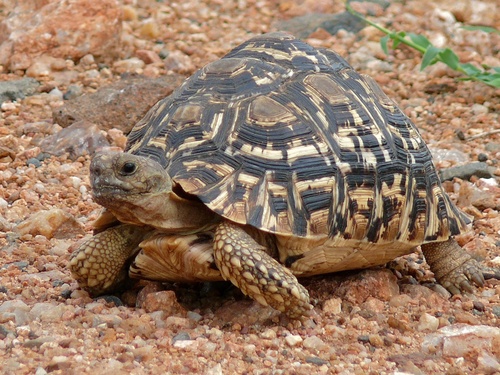
Leopard Tortoise
The Leopard Tortoise (Stigmochelys pardalis) boasts a striking patterned shell, thriving in African savannas. This herbivore aids in seed dispersal, showcasing its ecological importance. Renowned for longevity and resilience, it adapts to arid habitats, embodying nature's enduring elegance.
50-100 years
Lifespan
18.0 - 54.0 kg
Weight
Length: 40 - 70 cm
Size
Brown, Grey, Yellow, Black, Tan
Color
0.3 mph
Top Speed
Least Concern
Conservation Status
Unknown
Population Trend
Characteristics
Stigmochelys pardalis, commonly known as the Leopard Tortoise, is a large terrestrial reptile native to the savannas of Eastern and Southern Africa. It features a distinctive high-domed carapace with striking black and yellow patterns, resembling a leopard's spots. The tortoise is herbivorous, feeding on grasses, succulents, and fruit, and it plays a crucial role in seed dispersal within its ecosystem. Known for its resilience, the Leopard Tortoise can thrive in arid environments and is adept at digging to find food and water. It is also notable for its long lifespan, often exceeding 50 years.
Distribution Range of the Leopard Tortoise
Stigmochelys pardalis, commonly known as the Leopard Tortoise, is native to sub-Saharan Africa. Its geographical distribution spans across eastern and southern Africa, including countries such as Somalia, Ethiopia, Kenya, Tanzania, Zambia, Namibia, Botswana, Zimbabwe, and South Africa. It is also found in parts of Angola and Uganda.
Leopard Tortoise's Habitat
Environmental Conditions
Leopard Tortoises inhabit a variety of environments, but they are primarily found in savannas, grasslands, and semi-arid regions. These areas typically feature a mix of grasses, shrubs, and scattered trees, providing both food and shelter. The climate in these regions can range from hot and dry to more temperate, depending on the specific locale.
Ecological Niche
As herbivores, Leopard Tortoises play a crucial role in their ecosystem by helping to control plant growth and disperse seeds. They primarily feed on grasses, fruits, and succulents. Their ability to consume a wide range of vegetation helps them adapt to varying environmental conditions across their range. They are also known to occupy burrows or seek shelter under vegetation to escape extreme temperatures.
Copyright @ Nature Style Limited. All Rights Reserved.
 English
English